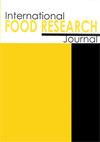Multiresidue analysis and health risk assessment of sulfonamides and quinolones from edible Batrachia and other aquatic products
IF 1
4区 农林科学
Q4 FOOD SCIENCE & TECHNOLOGY
引用次数: 0
Abstract
Tailless amphibians belonging to the order Batrachia are a significant component of human consumption. However, there is limited literature on the consumption of these amphibians by humans. Therefore, the present work aimed to examine the presence of drug residues in edible Batrachia, and compare them with other aquatic products. We assessed 22 veterinary drug residues, including 12 sulfonamides (SAs) and ten quinolones (QNs), in various aquatic products, including edible Batrachia. To provide a comparative analysis, we referenced literature from China between 2005 and 2020 regarding SAs and QNs detected in aquatic products. Additionally, we calculated the food safety index (IFS) of antibiotics, and conducted a health risk assessment. The findings revealed that the detection rate, average residual amount, and over-standard rate of antibiotics in edible Batrachia were higher than most other aquatic products. Furthermore, the systematic cluster analysis demonstrated that edible Batrachia could serve as a potential sentinel animal, distinguishing them from several other aquatic products. The total IFS of all residues obtained from different aquatic products in the present work was less than 1, thus indicating their safety in terms of public health. Nevertheless, it is essential to conduct detailed investigations into the maximum residues of certain antibiotics in specific aquatic products that exceed the safety limits to understand their impact on human health.食用蝙蝠蛾和其他水产品中的磺胺类和喹诺酮类药物的多残留分析和健康风险评估
属于蝙蝠纲的无尾两栖动物是人类消费的重要组成部分。然而,有关人类食用这些两栖动物的文献却很有限。因此,本研究旨在检测可食用蝙蝠蛾中是否存在药物残留,并将其与其他水产品进行比较。我们评估了包括食用蝙蝠蛾在内的各种水产品中的 22 种兽药残留,包括 12 种磺胺类药物(SA)和 10 种喹诺酮类药物(QN)。为了进行比较分析,我们参考了 2005 年至 2020 年间中国有关在水产品中检出 SAs 和 QNs 的文献。此外,我们还计算了抗生素的食品安全指数(IFS),并进行了健康风险评估。研究结果表明,食用蝙蝠蛾中抗生素的检出率、平均残留量和超标率均高于其他大多数水产品。此外,系统聚类分析表明,食用蝙蝠蛾可作为潜在的哨点动物,区别于其他几种水产品。在本次研究中,从不同水产品中获得的所有残留物的总 IFS 均小于 1,这表明它们对公众健康是安全的。不过,对于某些抗生素在特定水产品中的最大残留量超出安全限值的情况,有必要进行详细调查,以了解其对人类健康的影响。
本文章由计算机程序翻译,如有差异,请以英文原文为准。
求助全文
约1分钟内获得全文
求助全文
来源期刊

international food research journal
Agricultural and Biological Sciences-Food Science
CiteScore
1.40
自引率
0.00%
发文量
75
期刊介绍:
The International Food Research Journal (IFRJ) publishes papers in English, six (6) issues a year with the coverage of:
Food Science and Technology
Nutrition and Dietetics
Agriculture, multidisciplinary
Chemistry, multidisciplinary
The scope of the Journal includes:
Food Science, Food Technology and Food Biotechnology
Product Development and Sensory Evaluation
Food Habits, Nutrition, and Health
Food Safety and Quality
Food Chemistry, Food Microbiology, Food Analysis and Testing
Food Engineering
Food Packaging
Food Waste Management
Food Entrepreneur
Food Regulatory
Post-Harvest Food Management
Food Supply Chain Management
Halal Food and Management
 求助内容:
求助内容: 应助结果提醒方式:
应助结果提醒方式:


